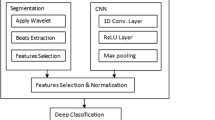Abstract
An automatic classification of abnormal heart rhythms using electrocardiogram (ECG) signals has been a popular research area in medicine. In spite of reporting good accuracy, the available deep learning-based algorithms are resource-hungry and can not be effectively used for continuous patient monitoring on portable devices. In this paper, we propose an optimized light-weight algorithm for real-time classification of normal sinus rhythm, Atrial Fibrillation (AF), and other abnormal heart rhythms using single-lead ECG on resource-constrained low-powered tiny edge devices. A deep Residual Network (ResNet) architecture with attention mechanism is proposed as the baseline model which is duly compressed using a set of collaborative optimization techniques. Results show that the baseline model outperforms the state-of-the art algorithms on the open-access PhysioNet Challenge 2017 database. The optimized model is successfully deployed on a commercial microcontroller for real-time ECG analysis with a minimum impact on performance.
Access this chapter
Tax calculation will be finalised at checkout
Purchases are for personal use only
Similar content being viewed by others
References
Arduino.cc. Arduino nano 33 ble sense - product reference manual (abx00031). https://docs.arduino.cc/hardware/nano-33-ble-sense
Banerjee, R., Ghose, A., Khandelwal, S.: A novel recurrent neural network architecture for classification of atrial fibrillation using single-lead ECG. In: 2019 27th European Signal Processing Conference (EUSIPCO), pp. 1–5. IEEE (2019)
Clifford, G.D., et al.: AF classification from a short single lead ECG recording: The physionet/computing in cardiology challenge 2017. In: 2017 Computing in Cardiology (CinC), pp. 1–4. IEEE (2017)
Datta, S., et al.: Identifying normal, AF and other abnormal ECG rhythms using a cascaded binary classifier. In: 2017 Computing in cardiology (Cinc), pp. 1–4. IEEE (2017)
David, R., et al.: Tensorflow lite micro: Embedded machine learning on tinyml systems. arXiv preprint (2020). arXiv:2010.08678
Fayyazifar, N.: An accurate CNN architecture for atrial fibrillation detection using neural architecture search. In: 2020 28th European Signal Processing Conference (EUSIPCO), pp. 1135–1139. IEEE (2021)
Glorot, X., Bengio, Y.: Understanding the difficulty of training deep feedforward neural networks. In: Proceedings of the Thirteenth International Conference on Artificial Intelligence and Statistics, pp. 249–256 (2010)
Han, C., Shi, L.: Ml-resnet: A novel network to detect and locate myocardial infarction using 12 leads ECG. Computer methods and programs in biomedicine 185, 105138 (2020)
Howard, A.G., et al.: Mobilenets: Efficient convolutional neural networks for mobile vision applications (2017). arXiv preprint arXiv:1704.04861
Integrated, M.: Integrated photoplethysmogram and electrocardiogram bio-sensor module for mobile health. https://www.maximintegrated.com/en/products/interface/signal-integrity/MAX86150.html
Jiang, M., et al.: Hadln: Hybrid attention-based deep learning network for automated arrhythmia classification. Front. Physiol. 12 (2021)
Li, D., Zhang, J., Zhang, Q., Wei, X.: Classification of ECG signals based on 1d convolution neural network. In: 2017 IEEE 19th International Conference on e-Health Networking, Applications and Services (Healthcom), pp. 1–6. IEEE (2017)
Li, Z., Zhou, D., Wan, L., Li, J., Mou, W.: Heartbeat classification using deep residual convolutional neural network from 2-lead electrocardiogram. J. Electrocardiol. 58, 105–112 (2020)
Liu, F., et al.: An attention-based hybrid ISTM-CNN model for arrhythmias classification. In: 2019 International Joint Conference on Neural Networks (IJCNN), pp. 1–8. IEEE (2019)
Park, J., Kim, J.K., Jung, S., Gil, Y., Choi, J.I., Son, H.S.: ECG-signal multi-classification model based on squeeze-and-excitation residual neural networks. Appl. Sci. 10(18), 6495 (2020)
Plesinger, F., Nejedly, P., Viscor, I., Halamek, J., Jurak, P.: Parallel use of a convolutional neural network and bagged tree ensemble for the classification of holter ECG. Physiol. Measur. 39(9), 094002 (2018)
Shi, J., Chen, C., Liu, H., Wang, Y., Shu, M., Zhu, Q.: Automated atrial fibrillation detection based on feature fusion using discriminant canonical correlation analysis. Comput. Math. Methods Med. 2021 (2021)
Sun, L., Wang, Y., He, J., Li, H., Peng, D., Wang, Y.: A stacked ISTM for atrial fibrillation prediction based on multivariate ECGs. Health Inf. Sci. Syst. 8(1), 1–7 (2020)
Warrick, P., Homsi, M.N.: Cardiac arrhythmia detection from ECG combining convolutional and long short-term memory networks. In: 2017 Computing in Cardiology (CinC), pp. 1–4. IEEE (2017)
Zhai, X., Tin, C.: Automated ECG classification using dual heartbeat coupling based on convolutional neural network. IEEE Access 6, 27465–27472 (2018)
Author information
Authors and Affiliations
Corresponding author
Editor information
Editors and Affiliations
Rights and permissions
Copyright information
© 2023 The Author(s), under exclusive license to Springer Nature Switzerland AG
About this paper
Cite this paper
Banerjee, R., Ghose, A. (2023). A Light-Weight Deep Residual Network for Classification of Abnormal Heart Rhythms on Tiny Devices. In: Koprinska, I., et al. Machine Learning and Principles and Practice of Knowledge Discovery in Databases. ECML PKDD 2022. Communications in Computer and Information Science, vol 1753. Springer, Cham. https://doi.org/10.1007/978-3-031-23633-4_22
Download citation
DOI: https://doi.org/10.1007/978-3-031-23633-4_22
Published:
Publisher Name: Springer, Cham
Print ISBN: 978-3-031-23632-7
Online ISBN: 978-3-031-23633-4
eBook Packages: Computer ScienceComputer Science (R0)




